Immunohistochemistry Catalog
Cytokeratin 18
Clone: R20-H
Cat#: DB 102
CK18 is a 45 kD a protein, belongs to the family of acidic type A and exists along with CK8 in most simple ductal and glandular epithelia. This antibody does not react with squamous epithelium . It reacts with benign and malignant epithelial lesions, the major ity of adenocarcinoma s, and basal cell carcinomas.
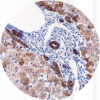
Fixed-embedded human liver
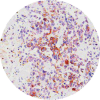
Fixed-embedded human lung adenocarcinoma
Cytokeratin 19
Clone: E16-L
Cat#: DB 103
The smallest human cytokeratin filament protein (40 kD) has been identified as CK19 and has been reported to be expressed in a large number of epithelial cell types, including many ductal and glandular epithelia.
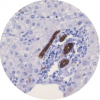
Fixed-embedded human liver
Cytokeratin 20
Clone: E19-I
Cat#: DB 119
CK20 has been demonstrated to be almost entirely confined to the gastro intestinal epithelium, urothelium and Merkel cells of the skin.
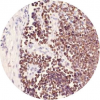
Fixed-embedded human Merkel cells carcinoma
Cytokeratin 5
Clone: XM26
Cat#: 10083
CK5 is an intermediate filament protein. Basal cells of epidermis express acidic CK14 and basic CK5. CK5 is a 58 kDa protein, which is closely related to CK6. XM26 can be useful in distinction of mesotheliomas from adenocarcinomas.
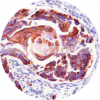
Fixed-embedded human lung squamous carcinoma
Cytokeratin 7
Clone: R17-S
Cat#: DB 051
CK7 has been reported in adenocarcinomas of the lung, breast, endometrium, ovary, thyroid as well as in carcinomas of the bladder and chromophobe renal cell carcinoma. CK7 and CK20 expression have been reported to show characteristic patterns on metastatic lung and adenocarcinomas.
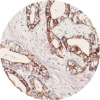
Fixed-embedded human pancreas adenocarcinoma
Cytokeratin 8
Clone: R15-K
Cat#: DB 098
CK8, also known as tissue polypeptide antigen (TPA), is one of the first cytokeratins expressed in the embryo and persists in adult tissues. It is a major components of all simple epithelia but not of stratified squamous epithelia.
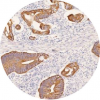
Fixed-embedded human colon adenocarcinoma
Desmin
Clone: E18-V
Cat#: DB 148
Desmin is an intermediate filament protein of both smooth and striated muscles. E18-reacts with striated (skeletal V and cardiac) as well as smooth muscle cells. In skeletal and cardiac muscles, the staining is confined to the Z-bands giving a characteristic striated appearance. Useful in indication of tumors of myogenic origin. It reacts with leimyosarcomas, as well as, rhadbomyosarcomas (striated muscle).
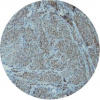
Fixed-embedded human uterus leiomyoma
DOG1
Clone: DOG1.1
Cat#: 10119
DOG1 is expressed ubiquitously in gastrointestinal stromal tumors (GIST) irrespective of kit or PDGFR alpha mutation status. Reactivity for DOG1 may aid in the diagnosis of GISTs, including PDGFRA mutants that fail to express KIT antigen, and lead to appropriate treatment with imatinib mesylate, an inhibitor of the KIT tyrosine kinase.
E-Cadherin
Clone: ECH-6
Cat#: 10072
E-Cadherin is a calcium dependent cell adhesion molecule, expressed predominantly in epithelial tissues. E-Cadherin has important role in growth and development of cells via the mechanisms of control of tissue architecture and maintenance of tissue integrity. Reduction and/or loss of E-Cadherin expression in carcinomas correlates positively with the potential of these tumors for invasion and metastasis.
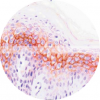
Fixed-embedded human skin
EBV/LMP
Clone: D24-G
Cat#: 10093
Epstein-Barr virus (EBV) is a virus of the herpes family (HHV-4), and is one of the most common viruses in humans. EBV is associated with a high proportion of cases of Hodgkin's disease, expression has also been found in nasopharyngeal carcinoma and non-lymphoblastic T-cell lymphomas.
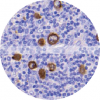
Fixed-embedded human Hodgkin lymphoma
EGFR
Clone: A20-E
Cat#: DB 092
Epidermal growth factor receptor (EGFR) is a transmembrane protein receptor of 170 kDa with tyrosine kinase activity. Increased level of EGFR is correlated with malignant transformation of squamous cells e.g. in squamous cell carcinoma of lung, head and neck, skin, cervix and oesophagus.
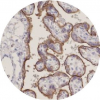
Fixed-embedded human placenta
EMA (CD227, Mucin-1)
Clone: G22-L
Cat#: DB 048
EMA is expressed on the apical surface of epithelial cells, especially of airway passages, breast and uterus. Also positive on activated and unactivated T cells and plasma cells. Over-expressed in epithelial tumors, such as breast or ovarian cancer and also in non epithelial tumor cells.
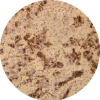
Fixed-embedded human lung adenocarcinoma
EpCAM
Clone: MOC-31
Cat#: 10129
This antibody reacts with a transmembrane glycoprotein present on most normal and malignant epithelia. Mesothelial cell derived tumors are negative.
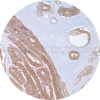
Fixed-embedded tissue
ER (Estrogen receptor)
Clone: S21-V
Cat#: DB 053
This antibody recognizes a protein of 67 kDa, which is identified as estrogen receptor (ER) and stains the nucleus of epithelial cells in breast carcinomas. The ER is an important regulator of growth and differentiation in the mammary gland. Presence of ER in breast cancers indicates an increased likelihood of response to anti-estrogen (e.g. tamoxifen) therapy.
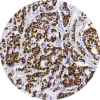
Fixed-embedded human breast cancer
GFAP
Clone: GA-5
Cat#: 10130
Glial Fibrillary Acidic Protein (GFAP) is specific to astrocytes (i.e., glial cells) and ependymal cells of the central nervous system. This antibody is useful in differentiating prima ry gliomas from metastatic lesions in the brain and for documenting astrocytic differentiation in tumors outside the CNS.
Glucocorticoid Receptor (GCR)
Clone: 3D5
Cat#: 10023
The 3D5 monoclonal antibody labels the cytoplasm and surface membrane of GCR producing cells in bone marrow, liver and other tissues.

Fixed-embedded human breast cancer
HISTOLS® c-erbB-2/HER2/neu (Two in One)
Clone: SP3+A24-V
Cat#: 10101
This mixture is a combination of a rabbit monoclonal (SP3) and a rabbit clonal (A24-V) antibody. It recognizes the c-erbB-2 protein on both its extracellular and intracellular domain. c-erbB-2/HER2/neu is a receptor tyrosine kinase of the c-erbB family. It is closely related in structure to the epidermal grovvth factor receptor. c-erbB-2 oncoprotein is detectable in a proportion of breast and other adenocarcinomas, as well as transitional cell carcinomas.
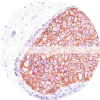
Fixed-embedded human breast cancer
HISTOLS® p504S/p63
Clone: 13H4+4A4
Cat#: 10050
This mixture of rabbit monoclonal (13H4) and mouse monoclonal (4A4) antibodies is helpful in distinguishing malignant from benign cells. Combined detection of p504S and p63 is useful for the diagnosis of prostate cancers. P504S is expressed in prostatic adenocarcinomas but not in benign glands. p63 is detectable in benign basal cells of the prostate and in other epithelial tissues. p504S is positive in cytoplasm of malignant and premalignant prostate glands, anti-p63 antibody is positive in benign glandular basal layer nuclei.
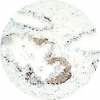
Fixed-embedded human prostate

